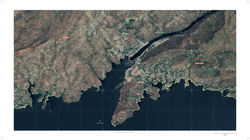ART
"OF TEA AND TISSUE"
 |  |  |  |  |  |
|---|---|---|---|---|---|
 |
WRITTEN WORKS
OIL SLICK METABOLISM
The phenomenon of the oil slick revolves around a particular false proverb that layers of oil and water do not mix, leading to false assumptions of potential futures. Along the water’s surface, a film of oil creates two imperfect mirrors, a combination of reflective and refractive light waves. On this surface, between the air and the oil, some light reflects and some light refracts. Just below the surface, between the water and the oil, some light reflects and some light refracts. And it is also here that, due to the thickness and density of the oil, there is a floating layer where the distance between the imperfect mirrors is the same as a wavelength of light. This inference of UV light causes light particles to evaporate and the heavy particles to sink, dissolving with the water. Aromatic compounds, like Benzol, Toluene, Xylene, and Ethylbenzene cannot be contained by current oil boom technologies. As they leech from containment infrastructures, they transgress into soils, waterways, and other networks.
Oil and water, it seems, do mix after all.

CONTESTING KARIBA, ZAMBIA VS ZIMBABWE
What is real Independence when you are stuck in the shackles of the Institution?
Unequal domestic classes and racial orders are fundamentally linked to an unequal world system. Keeping that order in place is one reason that capitalism and imperialism go hand in hand. Additionally, once African nations gain independence, they already start off handy-caped. What happens is, although they gain this independence, they are still stuck in the western political system, which is “bloated”. By “bloated” I am referring to the fact that there are a series of colonial influencers on the government payroll that heavily influence decisions. Therefore, for any government to make any significant change becomes impossible. They are still in the colonial system. This is something we still see present in many African nations to this day, often dictated after receiving IMF and World Bank bailouts. And we know what happens after that!
Some 70 years ago, white European men arrived at the Kariba Gorge to build a huge dam partially funded by the World Bank. A dam that was going to be the largest in the world, harnessing nature through a colonial imperialist form of hydropower in what is formally known as Rhodesia. Located on the Zambezi river, the Kariba Dam was shared between Northern Rhodesia(now Zambia) and Southern Rhodesia(now Zimbabwe). Conducted almost like an experiment, it is interesting to see how the two countries dealt with the implications of the piece of infrastructure. This paper examines the varying forms of resistance to policy that occurred, that ultimately resulted in the differing development and master planning within the two countries. Furthermore, analysing the different capacities of the two governments to various internal and external influences. What were the chain of consequences and who benefited more from the redistribution and adaption of life and non-life?

 |  |  |  |
|---|
"INBETWEENES AND AESTHETIC RESISTANCE"
Identity is something that has been intensively studied by both philosophers and sociologists. Philosophers believe that identity is something personal. It is the relation each thing bears on itself. Sociologists believe identity is collective and refers to qualities and expressions that make a group. Both definitions ultimately refer to the characteristics of who or what somebody/something is and that which makes them different from others. However, the context of thinking about where we belong can no longer be defined by purely geographic notion of place and historical sense of connection. The sense of ‘who we are’ and ‘where we belong’ has been crosscut by a variety of global forces. This is because we are living in times that are acutely shaped by the social, political, cultural and economic characteristics of globalization.
As American poet Audre Lorde famously stated, “the masters tools will never dismantle the masters house.” How much change can he insight at the helm and is it possible?
The rise of populist movements has seen a shift where people seek to reject a prescribed identity and instead form a new one. A hybrid one that I will refer to as “inbetweeness”. Hybridity is not just something natural, but is an identity of different styles. It re-evaluates the assumptions of identity. An identity that is therefore constructed in resistance to one that was initially prescribed. This is in attempt to shake up the establishment, regain power and move away from politics as usual. However, does aesthetics have the capacity to initiate similar modes of activism? Does aesthetics have the capacity to produce intellectual revolution, rejecting aspects of a central model?
The work of proclaimed critical theorists such as Homi Bhabha, Jacques Ranciére and Graham Harman has seen aesthetics shift from 19th Century Aestheticism, to today where aesthetics is one of the most important ways in which we understand the relationship to our environment. It is not only the appreciation of beauty, it is a form of engagement both cultural, socially and politically. This alignment of aesthetic has the potential to spark revolution, where a new identity can be formed from disruption.

A Sapeur posture and outfit is constructed to stand out. A voguing gesture. The Sapeurs' ability to transform a western suite and style is part of their new identity. The art of dressing is practiced as a cultural statement of empowerment.


The First Black Model to Open a Show in 164 years. Not only one Black Model, but 17 Black Models opened that day. Louis Vuitton Menswear Spring/Summer 2019, Paris Fashion Week. This is the point of difference Audre Lorde refers too. Diversity is the difference. This marks the beginning of new identity of inclusivity Virgil Abloh is presenting to the fashion industry.

W 57th St Residential Tower. Mark Foster Gage 102-storey Tower is an Intentionally Controversial
Gesture that goes Beyond current 20th C Modernist Trends